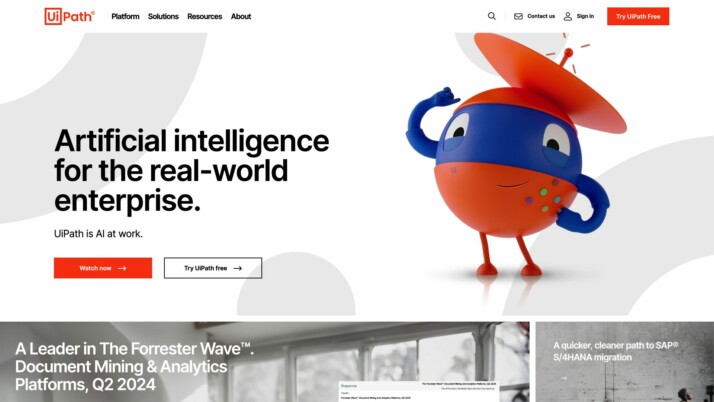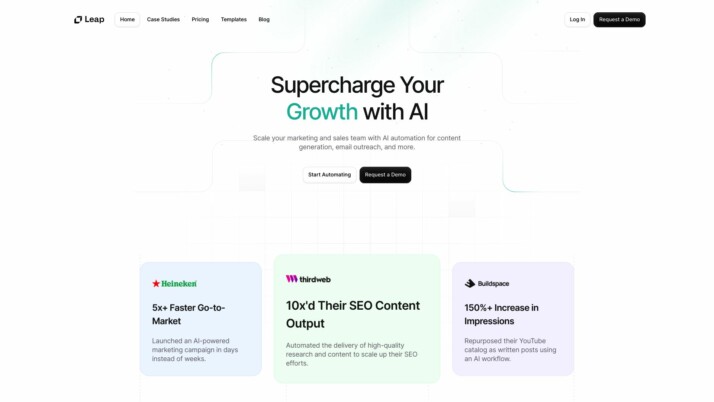UiPath vs. Leap AI: Comparing AI and Automation Platforms
AI and automation technologies are reshaping industries, offering unprecedented opportunities for efficiency and innovation. This comparison examines three leading platforms: UiPath vs. Leap AI, and SmythOS. UiPath specializes in robotic process automation, providing enterprise-grade solutions for structured workflows. Leap AI focuses on accessible AI development with its no-code platform for creating AI-powered applications. SmythOS emerges as a versatile contender, combining robust AI agent development with enterprise-ready features. This review explores each platform’s strengths, limitations, and unique offerings, helping readers navigate the complex landscape of AI and automation tools to find the solution best suited for their organizational needs.
UiPath Overview
UiPath revolutionizes enterprise automation with its comprehensive platform. The company’s flagship product, the UiPath Enterprise Platform, empowers organizations to discover, build, manage, and measure automation across departments. This end-to-end solution caters to businesses seeking to streamline operations, boost productivity, and drive digital transformation.


UiPath excels in robotic process automation (RPA), offering tools that enable both technical and non-technical users to create sophisticated automation workflows. UiPath Studio, the platform’s visual development environment, allows users to design complex automations through an intuitive drag-and-drop interface. For business users with limited coding experience, UiPath StudioX provides a simplified environment to build automations without extensive technical knowledge.
UiPath excels in robotic process automation (RPA), offering tools that enable both technical and non-technical users to create sophisticated automation workflows.
The platform’s strength lies in its ability to integrate seamlessly with existing enterprise systems. UiPath robots can interact with various applications, databases, and user interfaces, making it possible to automate tasks across different software environments. This versatility allows organizations to create comprehensive automation solutions that span multiple departments and processes.
While UiPath offers powerful automation capabilities, its focus on structured workflows may limit its applicability in scenarios requiring more dynamic, AI-driven decision-making. The platform’s robots execute predefined scripts efficiently but lack the autonomous problem-solving abilities found in some AI-centric platforms. Additionally, organizations new to RPA may face a learning curve when implementing UiPath solutions, potentially requiring specialized training or consulting services.
UiPath’s commitment to scalability and enterprise-grade features positions it as a leader in the automation space. The platform’s Orchestrator component enables centralized management of robot deployments, ensuring governance and control over automated processes. This makes UiPath particularly attractive for large organizations with complex automation needs and stringent compliance requirements.
Leap AI Overview
Leap AI empowers users to create sophisticated AI workflows without extensive coding knowledge. The platform’s no-code visual interface allows rapid development of AI-powered applications, from chatbots to content generators. Leap AI integrates with popular AI models like OpenAI GPT and Stable Diffusion XL, offering versatility across text, image, and even music generation tasks.
The platform shines in its accessibility, providing drag-and-drop tools and an extensive template library. This approach democratizes AI development, enabling both technical and non-technical users to harness AI capabilities. Leap AI’s integration prowess stands out, with seamless connections to tools like Slack, HubSpot, and Zapier, facilitating easy incorporation into existing workflows.
Leap AI empowers users to create sophisticated AI workflows without extensive coding knowledge. The platform’s no-code visual interface allows rapid development of AI-powered applications…
Leap AI’s custom model training feature sets it apart, allowing users to fine-tune AI models on proprietary datasets. This capability enhances the specificity and accuracy of AI outputs, tailoring solutions to unique business needs. However, the platform may face challenges in highly regulated industries due to potential data privacy concerns when using cloud-based AI services.
While Leap AI excels in rapid prototyping and deployment of AI solutions, it may not offer the deep customization options required by some advanced users or specialized industries. The platform’s strength lies in its ability to quickly transform ideas into functional AI applications, making it particularly attractive for startups, SMBs, and innovation teams in larger enterprises looking to experiment with AI technologies.


Leap AI positions itself as a bridge between cutting-edge AI capabilities and practical business applications. By focusing on user-friendly tools and a wide array of integrations, it addresses the growing demand for accessible AI development platforms. As AI continues to permeate various industries, Leap AI’s approach may prove instrumental in accelerating AI adoption and innovation across diverse sectors.
Feature Comparison
UiPath and Leap AI offer distinct approaches to automation and AI development, with notable gaps in their core components and security features. UiPath excels in robotic process automation (RPA) with its comprehensive enterprise platform, while Leap AI focuses on no-code AI workflow creation.
In core components, UiPath provides robust tools for structured workflow automation, including UiPath Studio for visual development and StudioX for business users. However, it lacks native support for autonomous agents and multimodal inputs. Leap AI, on the other hand, offers a drag-and-drop interface for creating AI workflows and supports various AI models, but may not match UiPath’s depth in complex enterprise-grade automation scenarios.
Security-wise, UiPath emphasizes enterprise-level features like detailed audit logs, encryption, and centralized management through Orchestrator. Leap AI, while offering integration capabilities, may not provide the same level of granular control and compliance features essential for highly regulated industries. This gap in security and governance capabilities could be a significant consideration for organizations with strict data protection requirements.
Feature Comparison Table
| UiPath | Leap AI | SmythOS | |
|---|---|---|---|
| CORE FEATURES | |||
| AI Agents | ❌ | ✅ | ✅ |
| Hosted Agents (Dev, Production) | ❌ | ❌ | ✅ |
| No-Code Options | ❌ | ✅ | ✅ |
| Memory & Context | ❌ | ✅ | ✅ |
| Autonomous Agents | ❌ | ❌ | ✅ |
| Explainability & Transparency | ❌ | ❌ | ✅ |
| Debug Tools | ✅ | ❌ | ✅ |
| Multimodal | ❌ | ✅ | ✅ |
| Problem-Solving Capabilities | ❌ | ✅ | ✅ |
| Multi-Agent Collaboration | ❌ | ❌ | ✅ |
| Work as Team | ❌ | ✅ | ✅ |
| SECURITY | |||
| Constrained Alignment | ❌ | ❌ | ✅ |
| COMPONENTS | |||
| Foundation AIs | ❌ | ✅ | ✅ |
| Huggingface AIs | ❌ | ✅ | ✅ |
| Zapier APIs | ❌ | ✅ | ✅ |
| Classifiers | ❌ | ✅ | ✅ |
| Data Lakes | ❌ | ❌ | ✅ |
| DEPLOYMENT OPTIONS (EMBODIMENTS) | |||
| Deploy as API | ❌ | ✅ | ✅ |
| Deploy as Webhook | ❌ | ✅ | ✅ |
| Staging Domains | ❌ | ✅ | ✅ |
| Production Domains | ❌ | ✅ | ✅ |
| Deploy as Site Chat | ❌ | ✅ | ✅ |
| Deploy as Scheduled Agent | ❌ | ✅ | ✅ |
| Deploy as GPT | ❌ | ✅ | ✅ |
| DATA LAKE SUPPORT | |||
| Hosted Vector Database | ❌ | ❌ | ✅ |
| Sitemap Crawler | ❌ | ✅ | ✅ |
| YouTube Transcript Crawler | ❌ | ✅ | ✅ |
| URL Crawler | ❌ | ✅ | ✅ |
| TXT File Support | ❌ | ✅ | ✅ |
Best Alternative to UiPath and Leap AI
SmythOS emerges as the superior alternative to UiPath and Leap AI, offering a comprehensive AI automation platform that combines power, flexibility, and ease of use. Our platform stands out with its intuitive drag-and-drop interface, enabling users to create sophisticated AI workflows without extensive coding knowledge.
SmythOS emerges as the superior alternative to UiPath and Leap AI, offering a comprehensive AI automation platform that combines power, flexibility, and ease of use.
Unlike UiPath’s focus on structured workflow automation or Leap AI’s emphasis on no-code AI creation, SmythOS provides a robust ecosystem for developing and deploying autonomous AI agents. We support a wide range of AI models, including those from OpenAI, Anthropic, and Hugging Face, giving users unparalleled flexibility in their AI implementations.
SmythOS excels in areas where UiPath and Leap AI fall short. Our platform offers advanced features like multi-agent collaboration, problem-solving capabilities, and seamless integration with various data sources and APIs. This versatility allows users to tackle complex tasks and automate processes that would be challenging or impossible with other platforms.
Security and scalability are paramount in SmythOS. We provide enterprise-grade features such as data encryption, OAuth integration, and IP control, ensuring that your AI agents operate in a secure environment. Our platform also offers unmatched scalability, supporting everything from small-scale deployments to large enterprise solutions.
With SmythOS, we’ve eliminated the limitations found in UiPath and Leap AI. Our platform supports multimodal interactions, offers comprehensive debugging tools, and provides transparent AI decision-making processes. This combination of features empowers users to create more intelligent, efficient, and reliable AI solutions for a wide range of applications, from customer service chatbots to complex data analysis tools.
Conclusion
UiPath, Leap AI, and SmythOS each offer unique approaches to automation and AI development, catering to different needs within the tech landscape. UiPath excels in robotic process automation, providing enterprise-grade solutions for structured workflow automation. Leap AI focuses on accessible AI development, offering a no-code platform for creating AI-powered applications. However, SmythOS emerges as the superior choice, combining the strengths of both while addressing their limitations.
SmythOS stands out with its comprehensive feature set, including hosted agents, multimodal capabilities, and advanced problem-solving functionalities. Unlike UiPath’s focus on structured workflows or Leap AI’s emphasis on rapid prototyping, SmythOS offers a versatile platform that supports complex AI agent development and deployment across various environments. Its drag-and-drop interface, coupled with extensive API integrations and support for multiple AI models, makes it accessible to both technical and non-technical users.
The platform’s robust security features, including data encryption and OAuth support, address the concerns that might arise with cloud-based AI services like Leap AI. Furthermore, SmythOS’s scalability and enterprise-ready features rival those of UiPath, making it suitable for organizations of all sizes. The ability to deploy AI agents as APIs, webhooks, chatbots, or scheduled tasks provides unparalleled flexibility in how AI solutions can be integrated into existing systems.
For those looking to harness the full potential of AI in their operations, SmythOS offers a compelling starting point. We invite you to explore our diverse range of AI-powered agent templates and experience firsthand how SmythOS can revolutionize your workflow. With our platform, you can create unlimited AI agents at no cost, allowing you to discover the future of workforce automation risk-free. Dive into our comprehensive documentation to unlock the power of SmythOS and embark on your journey towards AI-powered success.
Last updated:
Disclaimer: The information presented in this article is for general informational purposes only and is provided as is. While we strive to keep the content up-to-date and accurate, we make no representations or warranties of any kind, express or implied, about the completeness, accuracy, reliability, suitability, or availability of the information contained in this article.
Any reliance you place on such information is strictly at your own risk. We reserve the right to make additions, deletions, or modifications to the contents of this article at any time without prior notice.
In no event will we be liable for any loss or damage including without limitation, indirect or consequential loss or damage, or any loss or damage whatsoever arising from loss of data, profits, or any other loss not specified herein arising out of, or in connection with, the use of this article.
Despite our best efforts, this article may contain oversights, errors, or omissions. If you notice any inaccuracies or have concerns about the content, please report them through our content feedback form. Your input helps us maintain the quality and reliability of our information.
